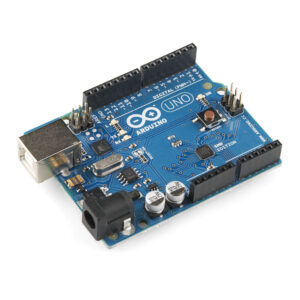Arduino Uno SMD

(picture by sparkfun.com)
We’re releasing a new version of the Arduino Uno today, the Uno SMD. This board is just like the current generation of Unos, but it features a surface-mounted version of the Atmega328 processor. The design of this board was prompted by a shortage of the Atmega328 in the through-hole DIP format that we normally use.
We plan to continue production of the Arduino Uno with the through-hole version of the Atmega328 as soon as they are available again. In the meantime, we took this as an opportunity to add a feature to the Uno board that will please the more advanced users, by making it easier to re-program the 8U2 processor that handles the USB-to-serial conversion.
Atmel, like all electronics components manufacturers, is gradually phasing out through-hole parts because they are more expensive to manufacture, and because surface-mount parts are cheaper and easier to assemble using robotic assembly. It makes hobbyists’ lives more difficult, because these parts are harder to assemble by hand, but it is a reality we all have to face. Fortunately, community knowledge is helping hobbyists to keep pace with large-scale operations. We recommend the many tutorials on surface-mount soldering like Sparkfun’s excellent ones here: http://www.sparkfun.com/tutorials/36. For the beginner, we recomment Adafruit’s excellent soldering resources as well: http://www.ladyada.net/learn/soldering/thm.html. We hope to see a tutorial on surface mount soldering the Atmega328 SMD parts online soon too — if you beat us to it, please send us a link that we can share. As the availability of through-hole parts diminshes, we will need to work together as a hobbyist community to keep electronics fabrication knowledge growing.
As I said, we took the opportunity to tweak a couple of things on the board. We brought out 4 pins from the 8u2 onto a 2×2 connector that can be used to create a “bit-banging” ISP programmer like some people have done with the FTDI chip on previous models. We also made it very easy to safely upgrade the firmware on the 8u2.
Now you just need to briefly connect to ground the reset pin of the 8u2 for it to enter DFU bootloader mode. The using Atmel’s FLIP on Windows and Linux or dfu-programmer on Mac (and Linux) you can reprogram the firmware.
We hope this will help us deliver improved versions of the 8u2 firmware more easily but also encourage people to experiment with it more!